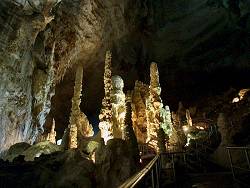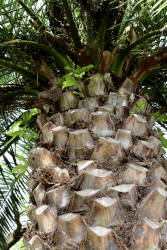Palm Trunk Stalagmite
Pine Cone Stalagmite - Stack-of-Plates-Stalagmite - Plate-Stack Shaped Stalagmites




This kind of stalagmite is very common in large caves. There are two preconditions necessary for the growth of this type of stalagmite:
The chamber must be close to the surface
In the area immediately below the surface, the flow of water is highly influenced by the weather.
The ceiling of the chamber must be very high, at least 30m
The height of the ceiling leads to a high speed of the falling drop and high energy when it hits the ground.
The diameter of the stalagmite depends on the height of the fall and the amount of water. When there is enough water the stalagmite grows with a rather big diameter, but if there is very little water, the stalagmite grows with a rather small diameter. The dramatic changes of water supply near the surface, leads to a dramatic change in diameters and therefore to this strange sort of stalagmites.
If the amount of water decreases, the diameter of the stalagmites suddenly becomes much smaller, a kind of plateau forms on which a thinner stalagmite continues to grow. If the amount of water increases again, the diameter increases only slowly, the growing diameter creates a conical shape. If this happens several times, the shape is reminiscent either of a palm trunk, which has very typical conical segments, or of a stack of plates. Sometimes the shape is also compared to fir cones or pine cones.
- J. Parmentier, S. Lejeune, M. Maréchal, F. Bourges, D. Genty, V. Terrapon, J.-C. Maréchal, T. Gilet (2019): A drop does not fall in a straight line: a rationale for the width of stalagmites, Royal Society, November 2019, Volume 475, Issue 2231. online
 Search DuckDuckGo for "Palm Trunk Stalagmite"
Search DuckDuckGo for "Palm Trunk Stalagmite" The Virtual Cave: Stalagmites
The Virtual Cave: Stalagmites
 Index
Index Topics
Topics Hierarchical
Hierarchical Countries
Countries Maps
Maps